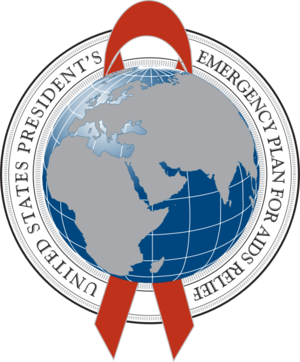PEPFAR
Construction Site
This article is work in progress and not yet part of the free encyclopedia IntactiWiki.
The President's Emergency Plan for AIDS Relief (PEPFAR) has begun providing money (United States tax dollars) for male circumcision programs.[1] Focus countries have been invited to request program funding to increase access to the procedure. According to Kent Hill (assistant administrator for USAID), funding will increase to be "an important part" of PEPFAR programs in coming years.[2]
For more, see USAID, CDC, and the NIH.
Contents
- 1 World AIDS Day (2010) Announcements
- 2 FACT SHEET: The Beginning of the End of AIDS 2011
- 3 President Obama announces bold new AIDS commitment 2011
- 4 Swaziland
- 5 PEFPAR promoting infant circumcision
- 6 PEPFAR's African Safaris
- 7 Investigations by the Office of Inspector General (OIG)
- 8 More revelations to come
- 9 CircWatch
- 10 References
World AIDS Day (2010) Announcements
FACT SHEET: The Beginning of the End of AIDS 2011
Note that the 60% is a relative risk reduction (absolute risk reduction 1.31%) during 18 months - not life-long.[3]
President Obama announces bold new AIDS commitment 2011
President Obama commemorated World AIDS Day by stepping up America’s commitment to the fight against AIDS, both domestically and internationally. In addition to his broad rhetoric on the importance — and feasibility — of ending AIDS, he made a number of specific commitments. The US will (among other commitments) provide support for more than 4.7 million voluntary medical male circumcisions in Eastern and Southern Africa over the next two years.[4]
Swaziland
PEPFAR is helping fund the "Accelerated Saturation Initiative", a program to circumcise 80% of the men ages 18 to 49 within the year 2011. [5] Additionally, it is working with the Swaziland Ministry of Health to introduce and scale up neonatal circumcision.[6]
Point of Interest: In recent studies, HIV transmission was found to be more prevalent in circumcised males in Swaziland. The drive to circumcise the majority of Swazi men continues none the less.[7]
PEFPAR promoting infant circumcision
"Typically, USAID’s policy is to circumcise males between the ages of 15 to 49, as one part of a comprehensive HIV/AIDS program. However, with encouragement from PEPFAR, the Raleigh Fitkin Memorial Hospital in Manzini, has led the way on infant circumcision, circumcising all male children born at the hospital since 2009 unless the parents opt out. This is a health facility delivering 8,000 babies a year where half of the women are HIV-positive). Prevention of mother to child transmission is now complemented with infant circumcision." [8]
From the PEPFAR Swaziland Operational Plan Report FY 2011 (emphasis added):[9]
From the PEPFAR Blueprint: Creating an AIDS-free Generation (emphasis added):[10]
PEPFAR's African Safaris
From a blog.AIDS.gov entry by Jeffrey S. Crowley, M.P.H., Director, Office of National AIDS Policy dated 26 May 2011:[11]
Investigations by the Office of Inspector General (OIG)
On the 15 June 2011, the OIG published a report critical of the Centers for Disease Control and Prevention's (CDC's) failure to oversee recipients’ use of PEPFAR funds.[12] The report read in part:
On the 19 November 2012, the OIG published a report critical of the CDC Namibia Office's failure to properly monitor recipients' use of PEPFAR funds [13]. The report read in part:
On the 4 February 2013, the OIG published a report critical of Namibia's Ministry of Health and Social Services failure to manage PEPFAR funds and meet program goals in accordance with award requirements [14]. The report read in part:
On the 12 February 2013, the OIG published a report critical of the CDC South Africa Office's failure to properly monitor recipients' use of PEPFAR funds [15]. The report read in part:
More revelations to come
From "Spotlight on... Grants Management and Oversight" published by the OIG on 4 February 2013:[16]
CircWatch
Post about PEFPAR on CircWatch
References
- Jump up ↑ Template:Cite web
- Jump up ↑ Template:Cite web
- Jump up ↑ Template:Cite web
- Jump up ↑ Template:Cite web
- Jump up ↑ Template:Cite news
- Jump up ↑ Template:Cite news
- Jump up ↑ As a substitute for the Wikipedia [Template:cite journal], please use Template:REFjournal on the IntactiWiki.
- Jump up ↑ Template:Cite web
- Jump up ↑ Template:Cite web
- Jump up ↑ Template:Cite web
- Jump up ↑ Template:Cite web
- Jump up ↑ Template:Cite web
- Jump up ↑ Template:Cite web
- Jump up ↑ Template:Cite web
- Jump up ↑ Template:Cite web
- Jump up ↑ Template:Cite web
